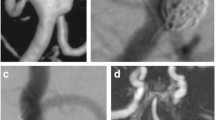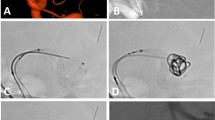Abstract
Purpose:
The authors share their extended experience using the Leo stent. Building on their earlier work, they present more cases, a longer follow-up period, and expansion of indications for use of the stent.
Patients and Methods:
A total of 71 patients with 75 aneurysms were included in this study. 61 saccular and broadnecked intracranial aneurysms and twelve fusiform lesions were treated electively.
Results:
Stent deployment was successful for 98% of the saccular aneurysms. Initial complete obliteration was achieved in 26 saccular aneurysms, a neck remnant in six, a residual aneurysm in four, while no immediate coil embolization was chosen for 25. Angiographic follow-up after 11 months available for 56 saccular aneurysms revealed unaffected parent arteries in 94%. Eleven saccular aneurysms exhibited spontaneous thrombosing after stent deployment without coiling and four lesions had recanalized (three residual aneurysms, one neck remnant). Regarding long-term follow-up ≥ 12 months, available for 26 saccular aneurysms, none of them showed parent artery affection. A recanalization was evident in three saccular aneurysms. All stents were successfully deployed for the fusiform aneurysms. Three patients with large fusiform aneurysms of the basilar artery had a lethal outcome. No clinical complications occurred in the remaining cases.
Conclusion:
The authors confirmed the efficacy of the Leo stent for the treatment of saccular and broad-necked intracranial aneurysms. Mid- and long-term follow-up demonstrated intact parent vessels and stable occlusion rates in the majority of patients. This device is a treatment option for fusiform lesions, but may confer a higher periprocedural risk.
Zusammenfassung
Ziel:
Basierend auf ihrer bisherigen Arbeit in der Anwendung des Leo-Stents präsentieren die Autoren hier eine größere Fallzahl, ein längeres Follow-up sowie eine Erweiterung der Indikation zur Verwendung des Stents.
Patienten und Methodik:
Insgesamt wurden 71 Patienten mit 75 Aneurysmen in diese Untersuchung aufgenommen. 61 sakkuläre und breitbasige intrakranielle Aneurysmen und zwölf fusiforme Läsionen wurden elektiv behandelt.
Ergebnisse:
In 98% der Fälle war die Stentplatzierung erfolgreich. Durch anschließendes Coiling wurde bei 26 sakkulären Aneurysmen ein kompletter Verschluss erzielt, ein Resteinstrom war bei zehn Aneurysmen manifest, während bei 25 Aneurysmen die Coil-Okklusion bewusst zu einem späteren Zeitpunkt erfolgte. Das angiographische Follow-up war bei 56 Aneurysmen nach 11 Monaten verfügbar und ergab in 94% intakte Trägergefäße. Elf sakkuläre Aneurysmen wiesen eine spontane Thrombosierung nach alleiniger Stentplatzierung ohne Coiling auf, während vier Rezidive manifest waren. Das Langzeit-Follow-up war für 26 Aneurysmen nach ≥ 12 Monaten verfügbar und wies in allen Fällen intakte Trägergefäße auf. Dabei traten drei Rezidive auf. In allen fusiformen Aneurysmen war die Stentimplantation erfolgreich. Drei Patienten mit einem großen fusiformen Aneurysma der Arteria basilaris verstarben, während in den übrigen Fällen keine klinischen Komplikationen auftraten.
Schlussfolgerung:
Die Autoren bestätigen in dieser Arbeit die Wirksamkeit des Leo-Stents in der Behandlung von sakkulären und breitbasigen intrakraniellen Aneurysmen. Das mittlere und Langzeit-Follow-up weist intakte Trägergefäße und stabile Verschlussraten in der Mehrzahl der Fälle auf. Die Behandlung von fusiformen Aneurysmen wird durch den Stent ermöglicht, beinhaltet jedoch ein höheres intraprozedurales Risiko.
Similar content being viewed by others
Author information
Authors and Affiliations
Corresponding author
Additional information
*Both authors contributed equally to this work.
Rights and permissions
About this article
Cite this article
Kis*, B., Weber*, W., Götz, F. et al. Endovascular Treatment of Cerebral Aneurysms Using the Leo Stent: Long-Term Follow-Up and Expansion of Indications. Clin Neuroradiol 17, 167–179 (2007). https://doi.org/10.1007/s00062-007-7019-z
Received:
Accepted:
Issue Date:
DOI: https://doi.org/10.1007/s00062-007-7019-z




